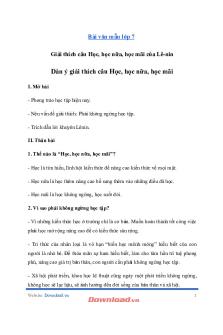Post Hoc SPSS example - post hoc test notes PDF

| Title | Post Hoc SPSS example - post hoc test notes |
|---|---|
| Author | Laura Andrews |
| Course | Educational Statistics Ii |
| Institution | Kent State University |
| Pages | 4 |
| File Size | 253.3 KB |
| File Type | |
| Total Downloads | 69 |
| Total Views | 194 |
Summary
post hoc test notes...
Description
Post Hoc Tests: SPSS Procedures and Results This file will cover how to run Post Hoc tests through the Analysis of Variance (ANOVA) function in SPSS. The file we will be using is titled “hourlywagedata.sav” which includes data from nurses. In this file, there are four variables; we will be focusing on two: “agerange” and “hourwage”. We will be running an F test with post hoc tests to determine if different age groups earned different amounts of money. To run post hoc tests, run a one-way ANOVA, follow the steps presented in Unit 2. In addition, when “Univariate” window is open, select “Post Hoc…”. You should see the following window:
As you can see, you cannot yet select post hoc tests yet. You need to move the variable, “agerange,” from the “Factor(s):” window to the “Post Hoc Tests for:” wondow. Then you can select from several post hoc tests. While you only really need to select one, I chose both Tukey and Scheffe for the sake of comparison.
Next, select “Continue” and then “Ok”. You should then see the output file. The output should look the same as the output for Unit 2. However, there will be a couple of additional tables at the end:
Post Hoc Tests Age Range Multiple Comparisons Dependent Variable:Hourly Salary Mean Difference (I-J) Std. Error * -1.1391 .35962
95% Confidence Interval
(I) Age Range 18-30
(J) Age Range 31-45
31-45
46-65 18-30
-1.6431* 1.1391*
.39429 .35962
.000 .005
-2.5686 .2949
-.7176 1.9832
46-65
46-65 18-30
-.5041 1.6431*
.28277 .39429
.176 .000
-1.1678 .7176
.1597 2.5686
18-30
31-45 31-45
.5041 -1.1391*
.28277 .35962
.176 .007
-.1597 -2.0207
1.1678 -.2574
31-45
46-65 18-30
-1.6431* 1.1391*
.39429 .35962
.000 .007
-2.6097 .2574
-.6765 2.0207
46-65
46-65 18-30
-.5041 1.6431*
.28277 .39429
.205 .000
-1.1973 .6765
.1892 2.6097
31-45 .5041 .28277 Based on observed means. The error term is Mean Square(Error) = 14.748. *. The mean difference is significant at the
.205
-.1892
1.1973
Tukey HSD
Scheffe
Sig. .005
Lower Bound Upper Bound -1.9832 -.2949
So, we have 3 different age rages that we are comparing: 18-30, 31-45, and 46-65. SPSS does not actually provide the value of the Tukey or Scheffe statistics themselves, but does provide the significance levels. You can fairly easily calculate the values yourselves from the values provided in the output. One thing you should notice is that each comparison is presented twice in the table above. For example, SPSS provides the results of the test comparing group 1 to group 2 AND comparing group 2 to group 1, so one difference will be negative and one will be positive. However, it’s the same statistical test, as indicated by the p value or “Sig.” level. The results of the Tukey test indicate that there are significant differences between the 18-30 age group and the other two groups. However, there is not a statistically significant difference between the 31-45 group and the 46-65 group.
The results are similar for the Scheffe test. However, notice that the p values, or “Sig.” values, are a little bit larger for the Scheffe test compare to the Tukey test. This is because the Scheffe test is a more “conservative” test than the Tukey test, so there is less chance of a Type I error. The final table is the “Homogeneous Subsets” table. This table just presents the same results in a different way. As you can see in the table, Subset 1 only includes the 18-40 group, as it significantly differs from the other two. Subset 2 includes both the 31-45 and 46-65 age groups because they do not significantly differ from each other.
Homogeneous Subsets Hourly Salary Subset Age Range Tukey HSD
Scheffe
a,b,c
a,b,c
N
1
18-30 31-45
144 548
46-65
278
Sig. 18-30 31-45
144 548
46-65
278
Sig.
2
19.0438 20.1828 20.6869 1.000 19.0438
.318 20.1828 20.6869
1.000
.352
Means for groups in homogeneous subsets are displayed. Based on observed means. The error term is Mean Square(Error) = 14.748. a. Uses Harmonic Mean Sample Size = 242.593. b. The group sizes are unequal. The harmonic mean of the group sizes is used. Type I error levels are not guaranteed. c. Alpha =...
Similar Free PDFs

Hoc hoc nua hoc mai cua Le nin
- 27 Pages

Example-Discussion Post
- 3 Pages

TIEU LUAN Triet hoc
- 18 Pages

Nhiet dong hoc
- 75 Pages

BT Nhiet dong hoc
- 5 Pages

Wpo persoonlijkheidspsychologie HOC
- 13 Pages

ATI - Profession Post test
- 2 Pages

Quizlet Informatics Post Test
- 2 Pages

Patho pre/ post Test
- 4 Pages

Am hoc kientruc
- 57 Pages

MOBIIA HOC amputatie
- 9 Pages

HOC #5 - Controls Testing
- 35 Pages
Popular Institutions
- Tinajero National High School - Annex
- Politeknik Caltex Riau
- Yokohama City University
- SGT University
- University of Al-Qadisiyah
- Divine Word College of Vigan
- Techniek College Rotterdam
- Universidade de Santiago
- Universiti Teknologi MARA Cawangan Johor Kampus Pasir Gudang
- Poltekkes Kemenkes Yogyakarta
- Baguio City National High School
- Colegio san marcos
- preparatoria uno
- Centro de Bachillerato Tecnológico Industrial y de Servicios No. 107
- Dalian Maritime University
- Quang Trung Secondary School
- Colegio Tecnológico en Informática
- Corporación Regional de Educación Superior
- Grupo CEDVA
- Dar Al Uloom University
- Centro de Estudios Preuniversitarios de la Universidad Nacional de Ingeniería
- 上智大学
- Aakash International School, Nuna Majara
- San Felipe Neri Catholic School
- Kang Chiao International School - New Taipei City
- Misamis Occidental National High School
- Institución Educativa Escuela Normal Juan Ladrilleros
- Kolehiyo ng Pantukan
- Batanes State College
- Instituto Continental
- Sekolah Menengah Kejuruan Kesehatan Kaltara (Tarakan)
- Colegio de La Inmaculada Concepcion - Cebu



